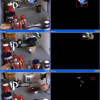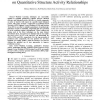627 search results - page 9 / 126 » Structural Learning of Activities from Sparse Datasets |
BMCBI
2008
13 years 8 months ago
2008
Background: Inferring gene regulatory networks from data requires the development of algorithms devoted to structure extraction. When only static data are available, gene interact...
ICCV
2007
IEEE
14 years 10 months ago
2007
IEEE
We propose an approach to activity recognition based on detecting and analyzing the sequence of objects that are being manipulated by the user. In domains such as cooking, where m...
IPMI
2005
Springer
14 years 9 months ago
2005
Springer
Modeling the variability of brain structures is a fundamental problem in the neurosciences. In this paper, we start from a dataset of precisely delineated anatomical structures in ...
CIBCB
2009
IEEE
13 years 9 months ago
2009
IEEE
Machine Learning techniques are successfully applied to establish quantitative relations between chemical structure and biological activity (QSAR), i.e. classify compounds as activ...
COLING
2010
13 years 3 months ago
2010
This paper presents a novel semisupervised learning algorithm called Active Deep Networks (ADN), to address the semi-supervised sentiment classification problem with active learni...


